The Use of Ultrasound in Endodontics
The importance of instrumentation in endodontics has reached strategic levels. The qualitative improvement of ultrasonic units and the increased availability of new tips go hand in hand with the constant refinement of endodontic techniques. Consequently, we have seen more highly developed ultrasonic sources that enable optimal use of all the tips available which, because of their variations, frequently demand specific methods of use. Modern ultrasonic units must be able to provide both high power and precision cutting, while being able to control not only the frequency but also the vibration amplitude.
This problem is particularly found in the endodontic field, where a variety of tips differing in shape, length, size, and construction are used. It is important that the ultrasonic source is specifically dedicated to endodontics, or at least is amultipurpose unit offering an “endo” application (an operative mode in which the amplitude of the vibrations is limited). The author’s preference is a very simple, small, and compact unit that is ergonomically easy to place, and yet provides a wide range of uses because of its ability to extensively and precisely vary operative frequencies: the Suprasson® P5 Newtron by Satelec® (Figure 1), or the more sophisticated and recent Suprasson P-Max Newtron®, which uses new technology that allows the unit and its power to be set automatically, optimizing the action of the tip to decrease the stress and increase the life of the tip (Figure 2).
It is necessary to avoid “closed” systems on which only tips specifically produced for that machine may be mounted, or systems in which the use of other tips is highly complex. With “open” systems it is possible to use almost all types of available tips. This is important because it is impossible to cover all clinical situations with a single family of tips. Tips differ not only in shape and length but also in composition. For years only steel was used, and many excellent tips produced that way are still being used today. For example, the new Pro-Ultra tips are coated with zirconium nitride, and other tips in the Pro-Ultra series are made of titanium that, because of their considerable differences in length, taper, and flexibility, cover a wide range of uses in various endodontic applications (Figures 3 and 4).
However, new tips need not entirely replace the old models; frequently they offer different characteristics in terms of performance and offer new working possibilities. In clinical practice, it may be useful in some cases to use steel tips with different characteristics. This is the case, for example, of the spreaders SP1, SP2, and SP3 by EIE, which are the longest tips available, and also of ET 20, ET 20D, ET 40, and ET 40D (Figure 5) or of the K files (Figure 6), both by Satelec, that can be irreplaceable instruments in some delicate canal situations.
The Clinic
The first clinical situation in which enormous advantages can be gained by using ultrasonic tips is in the preparation of access cavities and locating the canal orifices. This first stage of endodontic treatment is often complicated by the presence of pulp chambers that, over time, have become calcified and in which deposits of secondary dentin have formed that have partly or completely obliterated the root anatomy.
We know how complex it is in these situations to make a correct access cavity, respecting the original anatomy of the tooth, not altering the chamber floor, and above all locating all canal entrances. The control that ultrasonic tips provide is incomparably better than that offered by any rotating instrument, due not only to the ease of guiding an instrument that is not rotating, but also to the size of the tip, decidedly smaller, which provides both a very fine cut and better vision.
The most suitable tips for this operative stage are those with great taper and not excessive length. These are tips with good cutting capability that can be used at high power. For this reason, the tips used in these stages must be diamond-coated (ET 20D by Satelec) or zirconium nitride-coated (Pro-Ultra Endo 2-3) so that the ultrasonic tip can cut both at the point and along its edges.
Another ideal application for ultrasonic techniques is removing cast or preformed posts, screwed or cemented. The posts may be removed using ultrasonic tips alone or together with other tools such as a post extractor kit (PRS Ruddle Post-Extractor) (Figure 7).
For this purpose, a specific tip has been created: the Endo 1 Pro-Ultra, which may be vibrated at high power above the surface of the post. In removing old restorations, another important application exploits the cutting capability of the stronger tips to eliminate build-up material in teeth treated endodontically. The reconstruction usually involves the floor of the chamber, and to a varying depth also the canal orifices, making elimination of the entire build-up a far from simple operation. This may be particularly useful when the restoration material is composite resin that is very difficult to distinguish from dentin and to separate from the tooth surface; in these cases, ultrasonic power and frequency may both be very high (Figure 8).
Even when using high power, the pressure exercised on the handpiece should be light, with movements similar to those of a brush, to maintain tip integrity and to avoid needlessly overheating the handpiece and the tooth; these tips are designed to work without irrigation, leaving maximum visibility for the dentist.
During retreatment, emptying the canal anatomy of cement, gutta percha, or other material has always been very long and laborious. Today this operation is greatly simplified because the thin tips available easily enter the canal obturation material, enabling it to be removed.
A wide choice of tips is available, and deeper into the canal increasingly thin and flexible tips can be used (Titanium Series Pro-Ultra; Satelec K Files) that allow the root anatomy to be followed more closely.
All of this is highly effective with some materials, such as gutta percha, and on all traditional canal cements, but the situation is different if the cement used within the canal is for definitive cementations, something that unfortunately often happens not only when removing intracanal restorations such posts or screws, but also in cases of so-called “standard” retreatment.
In this case, the tips should be thin, but must also be sufficiently powerful to destroy the large fragments of cement that occlude the root canal system. If in the shallower part of the canal (coronal one-third) it may be possible to do this with the naked eye or under low magnification; deeper into the canal it is absolutely necessary to control the cutting action of these tips so that they can work exclusively on the cement and not on the canal walls.
The last application of ultrasonic endodontics is connected with preparation of the root canal system itself. Shaping with ultrasonic files, a common technique in the early 1980s, has now long been abandoned, and we can now exploit the cutting action of these tips in specific clinical situations that require a particular preparation of the anatomical defect, leaving aside canal shaping as such.
A typical example of this condition is perforation; in these cases it is indicated to exploit the controlled cutting action of ultrasonic tips to clean the defect of granulation tissue and to regularize the edges so as to predispose the cavity for correct obturation.
Today the use of ultrasonics may also be indicated to vectorize obturation material in these specific cases, where the most commonly used material to fill the defect is MTA (Pro-Root Dentsply-Maillefer), which under pressure of the vibrations adapts well to the prepared cavity, leaving a smooth and compact surface that gives an optimal seal to this serious anatomical defect.
This article was written by Dr. Fabio Gorni, past president of the Italian Society of Endodontics.
For More Information
Acteon Inc.
Phone: 1-800-289-6367
Web: www.acteongroup.com
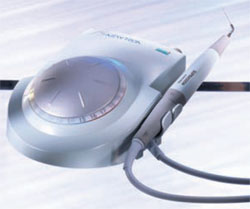 |  | |
| Figure 1 The Suprasson® P5 Newtron ultrasonic unit by Satelec®. | Figure 2 The Suprasson P-Max Newtron® allows power to be set automatically, optimizing the action of the tip to decrease the stress and increase the life of the tip. | |
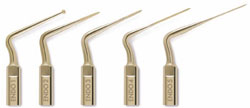 | 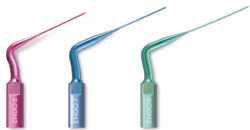 | |
| Figure 3 Pro-Ultra tips coated with zirconium nitride | Figure 4 Titanium Pro-Ultra tips cover a wide range of uses in various endodontic applications. | |
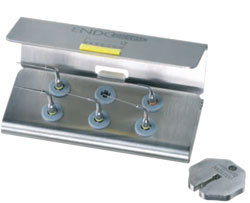 | 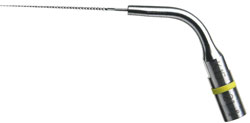 | |
| Figure 5 The EndoSuccess™ kit incorporating ET20 and Titanium Niobium tips. | Figure 6 A steel K file. | |
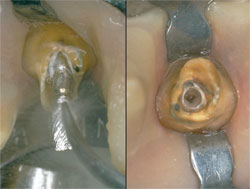 | 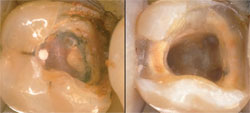 | |
| Figure 7 Removing cast or preformed posts with a post extractor kit. | Figure 8 High ultrasonic power and frequency may be needed when removing composite resin. |



